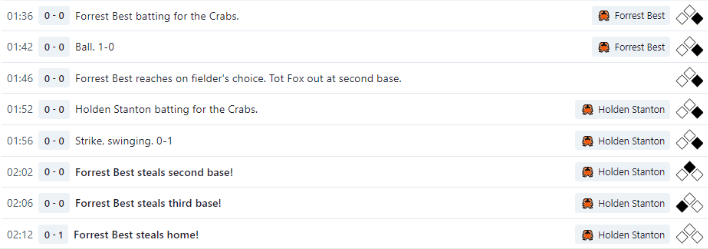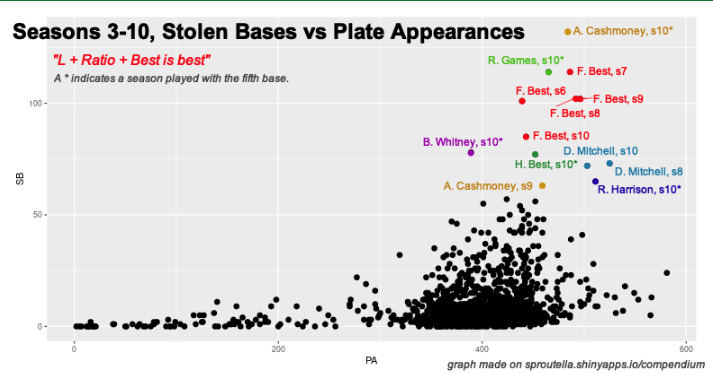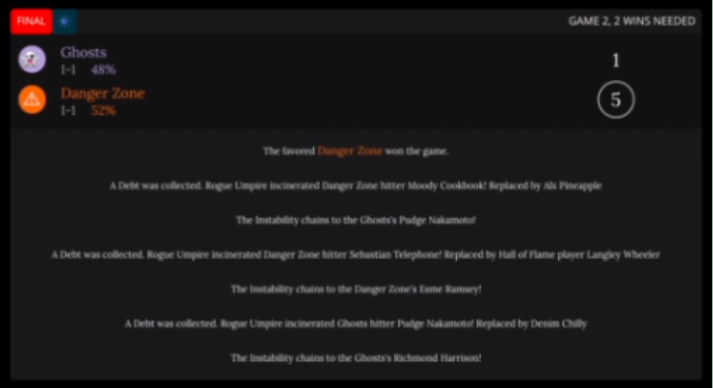Doing Crimes: Forrest Best is the Greatest Base Thief of All Time

by: Sam, Lux (Lucien Muse #5961), glumbaron (glumbaron#6398), beiju (beiju#9630), clowne (hee hee hoo hoo#6629)
Seasons 1-5: A Humble Crustacean
In the first season of Internet League Blaseball, Forrest Best was a player for the second-worst team in the ILB who, alongside the rest of its team, struggled to get on base, score, or do much of anything besides ground out. It was known in Crabs lore as a store mannequin with giant crab legs who was the best base thief on the team, with the very appropriate pregame ritual of Doing Crimes. Despite being a quickly-appointed fan favorite, Best still had a few notable things to work on— namely, getting to first. It seemed to love swinging at bad pitches and striking out as much as it loved its criminal activities on the field.
Nonetheless, by Season 5, Best managed to steal 19 bases in a single season, the best on the team (but far from the respectable 48 from base-stealing leaders Hewitt Best and Richardson Games). This would change during the infamous Season 5 Election when the Baltimore Crabs took home four Blessings, among them Rollback Netcode, Zombies, Run! Presents Horde Hallucinations, and Falling Stars. One of these stars was caught by our dear Forrest Best, and what it meant to be a base thief in the ILB was redefined forever.
Seasons 6-9: Changing the Game
In Season 6, Forrest Best more than doubled its criminal activity to 101 stolen bases, becoming the only player to break triple digits, a feat which continued for the next four seasons. It dominated the leaderboards, almost doubling the runner-up Don Mitchell, who stole 56 bases in what was their new career high. Forrest Best quickly rose to fame as the best base stealer in the League, successfully stealing 102 bases in a row in Season 8 before being caught for the first time that season in the playoffs. The crime spree continued season after season, with Best stealing so well and so frequently that it became a staple of watching any Crabs game.
From Season 6 through Season 10, Best led the League in steals of home plate every season, with a total of 62 across those 5 seasons. It set a record of 15 steals of home in Season 9 alone, which would not be surpassed until Season 19. In fact, over the course of the Discipline Era, Best became the inventor of so-called “stolen home runs”. This technique requires a player to reach first base and then make their way home entirely by stealing bases. Forrest Best famously did this 24 times in the Discipline Era. The runner-up clocked in at 10 stolen home runs… and by “runner-up,” I mean the combined stolen home runs of the entire Hades Tigers team during the Discipline Era.

It cannot be overstated just how efficient of a base stealer Best was. In an era where fans could go entire games without seeing a stolen base, Forrest Best was stealing so much, so fast, that it quickly became a core joy of watching the Crabs play. When Best was allowed on base via fielder’s choice, a fairly frequent occurrence, Crabs fans began to chant ”Wrong choice!” You just let a free run in.
Best’s proficiency with stealing home runs, which requires stealing three bases before the player’s teammates get a hit, is even more impressive considering in the Discipline Era it was followed by Crabs star Kennedy Loser (BA of .275 in seasons 3-10) and, when they weren’t busy in Breckenridge or a giant peanut shell, league all-star Nagomi McDaniel (.347). Best had to run fast to make it home before those two got a hit. So it did. In multiple instances it completed its run from first to home in a single at bat, such as this one on Season 6 Day 56.

Not satisfied with that, it proved it could even steal home without a single pitch being thrown to the next batter, see Season 6 Day 47.

Season 10: Ascension
In Season 10, Forrest Best stole less than 100 bases for the first time since winning the Falling Stars Blessing, and didn’t top the leaderboard. While perhaps initially alarming for Forrest Best fans, this shows just how much the game had to change to get Best off of its top spot.
During Season 10, every team outside of the Wild High Division was given the “Fifth Base” Modification, requiring them to run (or steal) one additional base before scoring. While a pain for many teams, this was a boon for aspiring base thieves who were now given the chance to steal an additional base per plate appearance. Not only that, but stealing from fourth to fifth base was actually the easiest base to steal, as was helpfully demonstrated by Aldon Cashmoney, who stole fourth base 6 times in Season 9 and 45 times in Season 10. This resulted in many personal bests for base thieves in other divisions, but did not provide the same benefit to base thieves in the Crab’s own Wild High Division.

Forrest Best was dethroned from its longtime residence in the top spot by two players from teams with the fifth base: Aldon Cashmoney and Richardson Games. Still, Best stole 85 bases and remained on the leaderboard at third. The only other Wild High player on the steals leaderboard in Season 10 was Don Mitchell in the 6th slot. Mitchell achieved 15% fewer steals than Best despite Reverberating allowing Mitchell 60 more plate appearances.
After this merely excellent season, Best pulled one final stunt for the Discipline Era: stealing an uninterrupted 16 bases over the Crabs’ 9-game sweep of the Season 10 postseason without ever being caught. The Crabs’ final play of the postseason was especially memorable: Forrest Best hit a single and stole twice to get to third, while Nagomi Mcdaniel waited patiently to bat it in on a sacrifice fly and win the game in extra innings securing the Crabs’ Ascension. Truly, there was no crabbier way to go.

Seasons 13-15: The Return
Unfortunately, while Forrest Best was indisputably the best base thief in the game, it was lacking in one crucial area: it had never been a great batter. After being cursed with Flinch during the fight against the Shelled One, Best’s weakness began to catch up with it, keeping it off base enough that it began to slip down the leaderboards.
In Season 13, Forrest Best ended with the fourth most bases stolen in the league. You might think this meant that Best was slowing down, failing to keep up with the new talent in terms of steal rate, but the spot that Best held on that board was interesting due to its aforementioned mediocre (and now Flinch-cursed) batting. While the rest of the top 5 base stealers were getting On Base Percentages between 0.299 (Goodwin Morin) and 0.415 (Logan Horseman), Best was only hitting a 0.265 that season, comparable to the 9th and 10th places on the board (Eizabeth Elliott and Hewitt Best), who had only 55 and 51 bases to Forrest Best’s cool 78. So not only was Forrest Best still keeping up with the rest of them, but it was doing it with far fewer chances to actually steal by simply doing it at every available opportunity.
The Season 13 postseason was the Crabs’ first since their ascension, and their fourth ring. Best helped, batting .370 and with an OBP of 0.433, as well as stealing 13 bases across nine postseason games. As the old adage goes: Best is Best.
Season 14 saw an even more pronounced leaderboard effect, with the Baltimore Crabs finally succumbing to full rebuild mode, losing their Fourth Strike modification and displaying the true toll of Flinch. Despite that significant hit to batting for the team overall, Forrest Best still tied with Don Mitchell for the number 4 spot on the leaderboard with 55 steals. This despite Don’s OBP of 0.305 being compared to Best’s meager 0.209— the lowest in the league’s top 10 base thieves by a full 0.026.
It was not to last however, as on Season 15 Day 31 Forrest Best was hit by a pitch from the traitorous NaN, after NaN received an echo from Chorby Soul and gained Debt, resulting in Best becoming Observed. At this point, Best was batting its best season since its return and had stolen 27 bases uninterrupted before it was Redacted at the end of play on Day 35. There are some things that even the best base thief in the game just can’t outrun.
At the time of its Redaction, Best held the ILB record for career stolen bases with 709— despite having missed two entire seasons following the Crabs’ Ascension.
Forrest Best did not appear again for nearly a full season, until Day 50 of Season 16, where it emerged from the Secret Base in the Steakhouse as an Attractor, and in true Best fashion promptly stole third before being batted in by the Dallas Steaks’ hitter Patel Beyonce, entering their Shadows.
Season 18: An Aside About Pitching
To those just learning about Forrest Best from this article, the Steaks’ decision to bring Best out to pitch will sound completely out of left field. So for some context, before getting into Forrest’s career on the Steaks, let’s zoom out on Best’s history with pitching in general.
The earliest known pitching stats for Best put it at a shocking 4.1 stars. For context, Jaylen “Incinerated for being the best pitcher” Hotdogfingers started out with 4.16. If you’re curious about the attributes: High in Unthwackability, with Ruthlessness following close behind. The Crabs had been aware of Best’s pitching potential, and the thought of making it pitch was raised several times. Each time it was decided that removing it from the basepaths would be unconscionable. Best remained a Lineup player for the Crabs, so its pitching ability didn’t become relevant until much later on.
Forrest Best’s first appearance as a pitcher wasn’t until the first Grand Siesta, during an exhibition series for a Blaseball Cares fundraiser. Best was drafted as a pitcher for the Danger Zone, and faced the Tsushima Ghosts’ own Polkadot Patterson in game two. Much of the data from this game is hard to gather or lost — just look at this screenshot— but we do know that Best dramatically struck out the Magmatic Nagomi Mcdaniel (their flinch mod was glitched, overriding the automatic Magmatic home run), three players were Incinerated, and Best won the game. The performance was spectacular, giving up only one run to a team made up of the best players in the league, including the aforementioned Nagomi, Valentine Games, Jessica Telephone, Richmond Harrison, and York Silk.

Having covered the fact that Best outpitched The Dot and gave up only one run to a dynamite offense on at least one occasion, we can now move on to its more canonical pitching career. It all began in the Season 17 Elections, when Steaks chose to Foreshadow Zoey Kirchner, bringing up Best for its time to shine. Across 11 games Forrest Best’s record was 8-3. All three lost games were given up to that season’s absolutely deadly Philly Pies— two games pitched by Elvis Figueroa, one by Henry Marshallow.
With a season ERA of 2.89 and a WHIP of 0.673 (in the Steakhouse), Best performed admirably, walking only three batters through day 58. On that fateful day, Forrest Best did what only the most talented base thief could. It stole its way back onto the Lineup where it could steal more bases, Reverbing back to bat for the Steaks. Best only spent a single pitch on base before its first steal of the season and hype among fans was high.
It is fascinating to try to imagine what could have been had Best gotten in a full season (or more) in the Rotation. The Ruthlessness Era was about to come to a close, but even without Ruthlessness, Forrest Best had no real weak spots in its 6-star pitching build. This Hall of Fame case is not about Best’s pitching career, or what could have been, but it may be worth noting to some voters that its time spent pitching was most definitely not time wasted.
Seasons 18-21: What is a Good Base Thief?
The League Forrest Best had left back in Season 15 was not the League it returned to now. In Season 18 Best finished out the tail end of the season with a fairly small sample size. In the 44 games Best spent batting, it stole just 15 bases and struggled to get to base with a 0.226 OBP on the Steaks’ 10 player Lineup.
In Season 19, though, Best clawed its way back onto the leaderboard with a fantastic 88 stolen bases. However with the tables turned and hype running rampant throughout the ILB, Best’s previous records were shattered by the breakout success of Collins Melons and Don Mitchell who stole 164 and 198 bases respectively. This left Forrest Best a very distant third place in the League.
This is where we should stop and talk about what a good base thief is. Up until now we’ve been discussing base theft in terms of the total number of bases stolen in the regular 99 game season, and using their on base percentage (OBP) to get a sense of time spent on base, and thus, opportunity to steal bases. But is that really measuring how good of a base thief you are? Or are we conflating your ability to get on base with your ability to steal from that base? Season 19 is an excellent opportunity to dissect this question.
To really understand just the base stealing component we’re going to look at the number of times players had the opportunity to steal, how often they actually stole, and just how successful they were at it. This lets us control for things like how often they made it to base, and how many Plate Appearances they got in a season.
Don Mitchell of the Hawai’i Fridays was on base 168 times in Season 19 and tried to steal 210 bases, meaning that for every time they got on base, Don tried to steal 1.25 times on average. Collins Melon made it on base 165 times and tried to steal 174 times, for a ratio of 1.05. Forrest Best made it on base just 91 times, and made 92 theft attempts, for a total of 1.01 bases stolen per opportunity to steal.
| Player | Times on Base | Steal Attempts | Steal Ratio |
| Don Mitchell | 168 | 210 | 1.25 |
| Collins Melon | 165 | 174 | 1.05 |
| Forrest Best | 91 | 92 | 1.01 |
with the next highest players being Richmond Harrison and Logan Horseman at 0.75.
But as any fans of a certain feisty Hawai’i Fridays captain can tell you, while a player’s willingness to steal is a vital contribution to their crimes, their success rate is just as important. Forrest Best is not only one of the prolific base stealers in the game, but also by far one of the most successful.
Unsurprisingly, the first time Best is the most successful base stealer in the League is Season 6, managing to be successful 93.1% of the time it tries to steal a base. In Seasons 7 and 8 this climbs to a 97% success rate. These two seasons represent the highest single season success rates for players with over 100 steals, including any in the Expansion Era.
While Forrest still remains above the 90% threshold for success for the next few seasons, it never hits the “most successful” mark again until Season 19, its first full season on the Lineup after its Redaction. While Mitchel and Melons were stealing more, they could only hold a 94.2% success rate, and Best was able to hit 95.6%— only being caught 4 times over the entire regular season.
So while comparing a direct counting stat like “total bases stolen” might make it seem like a mountain separates Forrest Best’s 88 from Don Michell’s 198, when you diverge the idea of a good batter from a good base thief Forrest’s thirst for crime and incredible success rate really highlight how it stayed in the game. A player who only got on base 91 times all season should not have been able to touch that stolen base leaderboard, but Best is the best base thief in the business, and proved that was just as true in Season 19 as it was in Season 6.
So what might have happened if Best got just a little better at getting on base? If it had managed to get a few more PAs each game? Could it have dominated the way that Don Mitchell and Collins Melons became famous for? Could it have become The Pickle Economy and been banished to the vault like so many others who flew too close to that golden sun?
We can never know, because in Season 20 Forrest Best was attacked by Consumers, dropping its already unoptimized batting from 4.33 stars to just 3, and its OBP dropped down to an abysmal 0.221 for that season. Worse, the hit to its baserunning meant that Best “only” stole 0.75 bases for each time it got on base, for a total of 52 stolen bases in the regular season. This was its lowest total for a full season since the Season 5 Election almost a full year earlier.
On Day 82 of Season 21 Forrest Best would face another Consumer attack, removing the last of its remaining soul patches, and making it the first and thus far only player to be Redacted twice.
Forrest Best has not been seen since. It is unknown if it will ever return to the ILB, or if it has been lost for good.
Career: Best is Best
So after a dominating Discipline Era, and a stubborn refusal to let go in the Expansion Era, where does that leave Forrest Best in the base stealing Hall of Fame?
A simple look at the career leaderboard shows Forrest Best stole 890 bases between all recorded regular seasons of Internet League Blaseball, landing it sixth on the list of most stolen bases in ILB history. What it leaves out is just how tenacious Forrest really was— managing to steal its way to sixth with just over 5500 plate appearances, the lowest number of plate appearances on that leaderboard by a margin of almost 2000, with Richmond Harrison in the above slot needing 9441 plate appearances to steal 918 bases, and Hewitt Best below taking 7255 appearances to steal 872 bases. Even without taking into account Forrest Best’s batting challenges, it’s obvious that it was a cut above what anyone else could manage.
Forrest Best successfully stole 30% of all bases between itself and home plate. This is the second highest percentage in the League, only being beaten by Goodwin Morin, who began their career with a full 7 stars of baserunning. In fact over its entire career Forrest Best spent 16.05% of its time on base stealing to the next base. The only player to try and steal more was Don Mitchell, who stole 16.97% of the time they spent on base. Even then, Mitchell only had a 89.82% success rate, while over its career Forrest Best was able to successfully steal 91.69% of the time— the third highest success rate in the league behind a pair of players who only spent 12.5% of their time stealing.
In Season 7 Forrest Best set the record for wSB with at 22.3, representing 114 stolen bases with a .278 OBP. This record stood for until Season 19, only being broken by the likes of Collins Melon and Don Michell at the peak of their performance and rapidly inflating stars and steals of the late Expansion Era.
Not only was Forrest Best the first transcendent base thief in the ILB, but even as it was beaten down by consumers, star inflation, and the gods themselves, it refused to give up its title. Perhaps more than any other player, Best defined the Baltimore Crabs, helping win four of the Crabs’ five championships, and being a delight to watch steal its way through the league.
It stole bases, it stole our hearts, and now it’s stealing your vote.
Vote Forrest Best for the Blaseball Hall of Fame.



